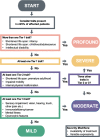Evaluation and classification of severity for 176 genes on an expanded carrier screening panel
- PMID: 32474937
- PMCID: PMC7540025
- DOI: 10.1002/pd.5762
Evaluation and classification of severity for 176 genes on an expanded carrier screening panel
Abstract
Background: Disease severity is important when considering genes for inclusion on reproductive expanded carrier screening (ECS) panels. We applied a validated and previously published algorithm that classifies diseases into four severity categories (mild, moderate, severe, and profound) to 176 genes screened by ECS. Disease traits defining severity categories in the algorithm were then mapped to four severity-related ECS panel design criteria cited by the American College of Obstetricians and Gynecologists (ACOG).
Methods: Eight genetic counselors (GCs) and four medical geneticists (MDs) applied the severity algorithm to subsets of 176 genes. MDs and GCs then determined by group consensus how each of these disease traits mapped to ACOG severity criteria, enabling determination of the number of ACOG severity criteria met by each gene.
Results: Upon consensus GC and MD application of the severity algorithm, 68 (39%) genes were classified as profound, 71 (40%) as severe, 36 (20%) as moderate, and one (1%) as mild. After mapping of disease traits to ACOG severity criteria, 170 out of 176 genes (96.6%) were found to meet at least one of the four criteria, 129 genes (73.3%) met at least two, 73 genes (41.5%) met at least three, and 17 genes (9.7%) met all four.
Conclusion: This study classified the severity of a large set of Mendelian genes by collaborative clinical expert application of a trait-based algorithm. Further, it operationalized difficult to interpret ACOG severity criteria via mapping of disease traits, thereby promoting consistency of ACOG criteria interpretation.
© 2020 The Authors. Prenatal Diagnosis published by John Wiley & Sons Ltd.
Conflict of interest statement
Aishwarya Arjunan, Holly Bellerose, Raul Torres, Rotem Ben‐Shachar, Jennifer Tarpinian, Gabriel A. Lazarin, and Katherine Johansen Taber are all current or former employees of Myriad Women's Health, which markets an expanded carrier screening panel.
Figures




References
-
- Haque IS, Lazarin GA, Kang HP, Evans EA, Goldberg JD, Wapner RJ. Modeled fetal risk of genetic diseases identified by expanded carrier screening. JAMA. 2016;316(7):734‐742. - PubMed
-
- ACOG Committee on Genetics . ACOG Committee Opinion No. 690: carrier screening in the age of genomic medicine. 2017. - PubMed
-
- Grody WW, Thompson BH, Gregg AR, et al. ACMG position statement on prenatal/preconception expanded carrier screening. Genet Med. 2013;15(6):482‐483. - PubMed
-
- Kraft SA, McMullen CK, Porter KM, et al. Patient perspectives on the use of categories of conditions for decision making about genomic carrier screening results. Am J Med Genet A. 2018;176(2):376‐385. - PubMed
Publication types
MeSH terms
LinkOut - more resources
Full Text Sources
Medical
Research Materials
Miscellaneous

